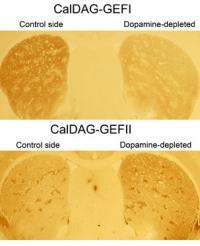What causes motor complications of Parkinson's treatment?

People with Parkinson's disease commonly suffer a slowing or freezing of movement caused by the death of neurons that make dopamine, a key chemical that allows brain cells to send and receive messages essential to voluntary movements. Patients regain the ability to move, seemingly miraculously, by taking L-DOPA or related drugs that mimic the missing dopamine. After a few years on L-DOPA, however, most patients again lose motor control — but in an opposite way. Instead of too little, there is too much movement, like involuntary nodding and rocking — side effects known as L-DOPA-induced dyskinesias.
"L-DOPA-induced dyskinesias are a major problem for patients, and there is a great need to help with these drug side effects," said MIT Institute Professor Ann Graybiel, a prominent Parkinson's researcher at the McGovern Institute for Brain Research at MIT.
Graybiel and her colleagues have identified two molecules whose expression in the brain is altered in the brains of animals with L-DOPA-induced dyskinesias. The results may lead to new approaches to the treatment of dyskinesias in Parkinson's patients, of which there are more than 1 million in the United States alone.
"We're very excited because these genes are concentrated in precisely the places that lose dopamine in Parkinson's disease, so they might be reasonable targets to go after therapeutically," Graybiel said. This research was published Jan. 26 in the advance online issue of Proceedings of the National Academy of Sciences.
The two related genes, named CalDAG-GEFI and CalDAG-GEFII, which are believed to be involved in signaling inside neurons, are expressed in the striatum, a brain structure essential for the control of movement and the main target of the dopamine-containing nerve tract that degenerates in Parkinson's disease.
In a rat model of Parkinson's disease, the two genes showed opposite changes when the animals were treated with L-DOPA. CalDAG-GEFI showed decreased expression while CalDAG-GEFII was increased.
"Moreover, the changes in the rat brain were proportional to the severity of the drug-induced dyskinesias. The more exaggerated the movements, the greater the dysregulation of these genes," said first author Jill Crittenden, a research scientist in the Graybiel Lab.
These CalDAG-GEF genes are thought to work by controlling the activity of other important signaling molecules (Ras, Rap and ERK) that are expressed in many different parts of the body and have many different biological functions. Other labs have shown that inhibiting Ras or ERK in animal models of dyskinesias prevents these involuntary movements.
"But because Ras and ERK do so many things, they are not promising drug targets because blocking them would probably have many unwanted effects," Crittenden said. "Because the CalDAG-GEF molecules control ERK and because they are so enriched in the very part of the brain that controls these involuntary movements, regulating them could have therapeutic value for dyskinesia without causing other problems."
Source: Massachusetts Institute of Technology




















